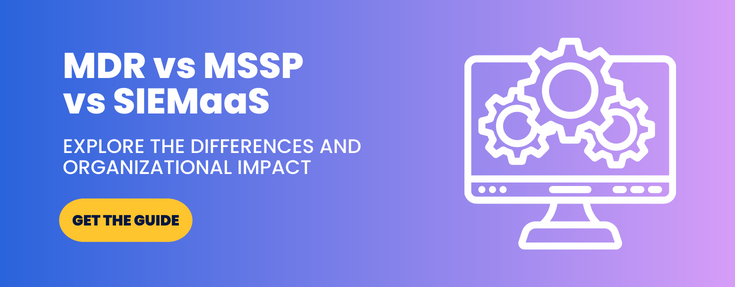SIEM vs MSSP: What's the Difference?

 By
Jason Miller
·
4 minute read
By
Jason Miller
·
4 minute read
Cybersecurity incidents are a constant threat to modern organizations. Security solutions must be robustly addressed in order to prevent data breaches, hacks, and numerous other security-related issues.
If you’re doing research into the most well-rounded approaches to cybersecurity, you’ll likely see constant references to two acronyms: SIEM and MSSP.
But you don’t need more technobabble alphabet soup. You just want to keep your systems, and the sensitive data in your care, secure.
Below, we’ll look to explain both of these acronyms, and most importantly, outline how combining MSSPs and SIEM can be hugely beneficial.
What Is SIEM?
SIEM stands for “security information and event management”, a software product that can be used to ensure the security of an organization’s entire IT infrastructure.
Initially, SIEM was primarily used by large organizations that required advanced monitoring of their overall cybersecurity. But as time has shown that no organization is too small for criminal hackers to target, SIEM has become more popular with small and medium-sized businesses also.
There are, of course, a number of different types of cybersecurity-focused software, tools, and programs, all of which have their own unique merits. But the days of slapping up some firewalls and downloading some anti-virus software are in the past.
SIEM tools are valuable because they allow log data to be centrally collected from applications, hardware, networks, and similar sources… in real time. This leads to more effective threat detection and security incident recovery.
Modern SIEM software is capable of not only managing the security of an organization’s entire IT infrastructure but can also be used to generate security compliance reports. Given that data security and regulation is now a significant concern for organizations – especially with the introduction of legislation such as the EU’s GDPR – this streamlined combination of security techniques and compliance reporting is inherently beneficial.
SIEM tools should are among the most potent security tools for any modern organization, offering in-depth and real-time cybersecurity protection and assisting with related regulatory compliance as required – a complete, all-encompassing solution.

What are MSSPs?
MSSP stands for “managed security services provider”. Essentially, an MSSP is an individual agency which provides IT security services to existing companies.
For example, if a small to medium-sized business wishes to increase their cybersecurity provision, they could work with an MSSP in order to achieve this without the need to set up an in-house IT team.
The exact services provided by individual MSSPs tend to differ, with each company offering different levels of security management, areas of focus, and system management capabilities.
Some MSSPs will focus primarily on cybersecurity requirements such as virus and spam blocking, or VPN management. Other MSSPs may offer the aforementioned services also, but will also offer services such as system modifications, customizations, and upgrades if required.
MSSPs have become popular due to the specialist security provision they are able to offer. Unfortunately, many organizations with in-house security teams have fallen into the habit of essentially ignoring threats that are detected by on-prem security software, often due to a large volume of false positives or issues regarding the complexity of the security systems that are in use.
Alarm fatigue is real, and it could be leaving a hole in your digital security.
MSSPs are able to completely take the weight of managing an organization’s entire IT infrastructure so that the organization can focus its in-house time and resources on the business’ non-security related needs.
How are SIEM and MSSPs related?
SIEM is a product, while MSSPs provide a service. They can exist separately from one another. For example, a company could choose to use SIEM as part of their in-house security provision, or MSSPs could theoretically choose to offer their services without using SIEM technology at all.
However, by far the most effective cybersecurity provisions are found when these two beneficial elements – MSSPs and SIEM tools – are united.
Recognizing the inherent value of SIEM to their work, more and more MSSPs have sought to utilize SIEM as part of their overall offering to their clients.
What are the benefits of working with an MSSP who uses SIEM tools?
SIEM tools and software require constant vigilance, which is complicated by issues such as the false positives we mentioned earlier.
The sheer breadth and scope of SIEM does make false positives and missed incidents more likely – SIEM tools are, after all, designed to be as comprehensive as possible in order to provide a complete overview of every aspect of an organization’s IT.
As a result, in-house IT departments may quickly find that while SIEM tools are undoubtedly useful, they demand time, resources, and expertise that an in-house team may not necessarily possess.
In such a scenario, the functionality of SIEM is compromised. Simply using SIEM tools alone won’t offer sufficient protection to business; these tools have to be understood and fine-tuned in the context of your organization’s digital fingerprint.
Given that training staff is an expensive and arduous undertaking, and hiring new specialist staff all the more problematic, outsourcing to experts who already understand the ins and outs of SIEM tools, (and are willing to partner with you to understand how your business uses technology day by day,) can be the simplest, most cost-effective choice for any organization.
MSSPs do have the time, knowledge, and expertise required to use SIEM tools to their greatest efficacy, ensuring that they are able to provide their clients with complete security (and security compliance,) solution.
When in the hands of a reputable MSSP, SIEM tools are at their most potent, allowing for fast, efficient threat detection, analysis, monitoring, and compliance reporting – which is inherently positive for the business as a whole.
For organizations hoping to find a robust, comprehensive solution to their cybersecurity and compliance needs, managed SIEM for MSSP services are a natural choice. The business can enjoy the advantages of fully-functioning SIEM monitoring and reporting with ease, but without placing unnecessary stress on in-house staff and resources – truly the best of both worlds.
If you’re interested in a robust SIEM as a Service solution, we’d love to talk. Set up a short conversation today and see how BitLyft can help enhance your IT environment’s security.
